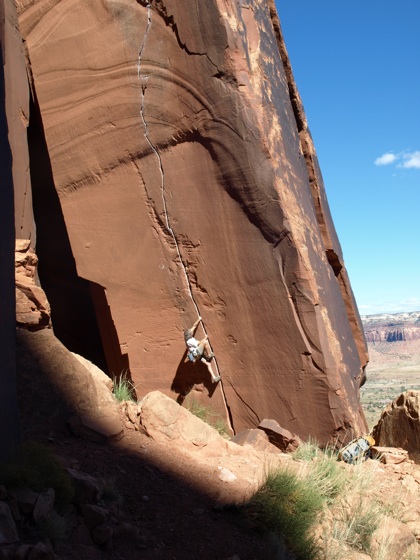 Crack climbing was first introduced to me in the summer of 2007 by three NOLS instructors, who are also enthusiastic crack climbers; I was highly intrigued. My first encounter of a 5.7 crack felt like a 5.9. Then when I tried a real 5.9 crack with an off-width start it was a mission impossible. Not trusting any of my jams and unable to have an ease of mind, I strangled all my body parts and had to quit before reaching the top anchor. The experience sounds like a total disaster, right? Yes, but once I felt a perfect jam, I forgot the rough path leading to it. Just like when reaching a summit, I no longer mind the heavy pack on my back.
Crack climbing was first introduced to me in the summer of 2007 by three NOLS instructors, who are also enthusiastic crack climbers; I was highly intrigued. My first encounter of a 5.7 crack felt like a 5.9. Then when I tried a real 5.9 crack with an off-width start it was a mission impossible. Not trusting any of my jams and unable to have an ease of mind, I strangled all my body parts and had to quit before reaching the top anchor. The experience sounds like a total disaster, right? Yes, but once I felt a perfect jam, I forgot the rough path leading to it. Just like when reaching a summit, I no longer mind the heavy pack on my back.
Experienced climbers told me “crack climbing is all about techniquesâ€; instructional books said that learning how to climb cracks is like learning to ride a bicycle, once you get it, you have it. I love technique-oriented climbing, because I am never the one able to “power through†a climb. Besides, I know how to ride a bike; there is no reason I can’t crack climb. Therefore I was at Indian Creek, the ultimate destination for crack climbing, undergoing an intense 3-day crack climbing training – the Splitter Camp.
I can’t remember how many climbs I did, I just know it was many. My body was a bit sore after the first day; normal. The last climb of the second day, which was a 5.11+, thin hands plus a lie-backing overhang declared the death of my arms. To get my money’s worth, I kept climbing on the third day with no reserve. I didn’t feel my arms during any of the climbs and at the end my legs were pumped. Wow, the experience was new and magical – I learned that I can climb more than I thought, if my mind really wants to.
So, what did I learn from the camp? The most valuable take-home lesson for me is that I have to be creative, and the sky is the limit for my imagination. Crack climbing is about securing our body parts in a natural feature (i.e. cracks) and then applying weight or tension to the lock-offs in order to generate an upward force.
There are many ways to jam our body parts in a crack, starting from finger locks to a whole body jam. It’s like putting protection gear in a crack, instead of using a real pro such as a cam or a nut, you use your body parts depending on the size of the crack. And just like having two types of protection gear: active and passive, the body parts can be applied passively and actively. For example, you can jam your thigh by inserting your knee straight into a crack, which you mostly utilize the normal size of your thigh. However, by rotating the outside lower leg (or the outside foot), you can change the size of your thigh to optimize the jam.
The contraction of muscles changes the size of a jam. A change of orientation can also make the size differ. For example, when a hand crack narrows down, it might be the time to start using a thumb-down hand jam. Also by putting the thumb in different locations, say between different fingers, you change the size of a hand jam. There are numerous examples like these. The wilder your imagination goes, the larger the rack your body offers.
I hope that soon I will crack climb better than I bike, but during the 3 days I did learn that after a few laps a 5.9 crack can feel like a 5.7 face climb. Too bad that I haven’t gotten enough “friends†to plan a personal trip back to Indian Creek but the day will come sooner than expected.
Photo credit: Mark Rupert

As always I love reading your blogs. I have still only read a couple but again enjoyed this reading. I like how you compare it to bike riding. I have only done a little bit of crack climbing; it is definitely tough for me. I REALLY appreciate you sharing some of the techniques and will try to apply some of this!!
It sounds awesome.
Great read, I’d really like to attempt this one day. Of course there aren’t many places around where I live for crack climbing..
Pingback: LittlePo: An Outdoor Blog » Blog Archive » Yangshuo China Trip Report – Thumb Peak thru Happy New Year (5.10b)